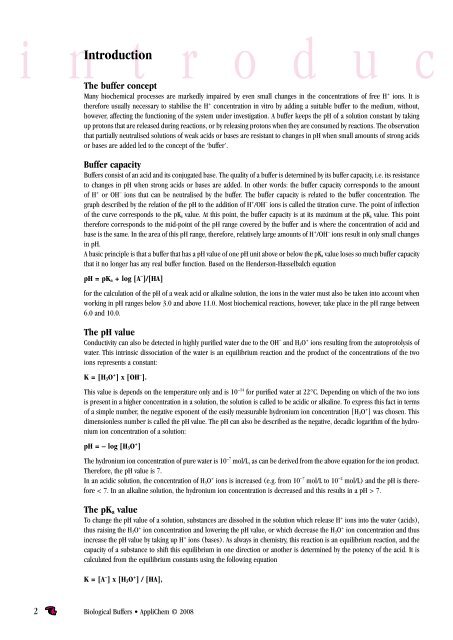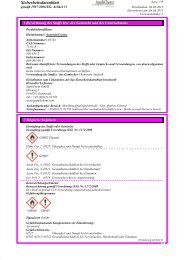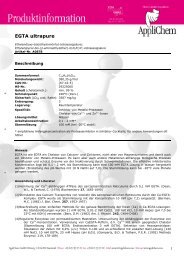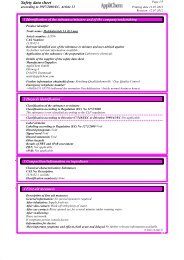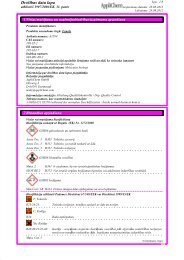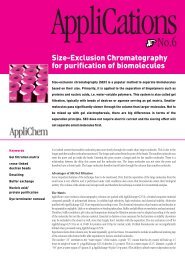Biological Buffers • AppliChem
Biological Buffers • AppliChem
Biological Buffers • AppliChem
You also want an ePaper? Increase the reach of your titles
YUMPU automatically turns print PDFs into web optimized ePapers that Google loves.
i n t r o d u c<br />
Introduction<br />
The buffer concept<br />
Many biochemical processes are markedly impaired by even small changes in the concentrations of free H + ions. It is<br />
therefore usually necessary to stabilise the H + concentration in vitro by adding a suitable buffer to the medium, without,<br />
however, affecting the functioning of the system under investigation. A buffer keeps the pH of a solution constant by taking<br />
up protons that are released during reactions, or by releasing protons when they are consumed by reactions. The observation<br />
that partially neutralised solutions of weak acids or bases are resistant to changes in pH when small amounts of strong acids<br />
or bases are added led to the concept of the ‘buffer’.<br />
Buffer capacity<br />
<strong>Buffers</strong> consist of an acid and its conjugated base. The quality of a buffer is determined by its buffer capacity, i.e. its resistance<br />
to changes in pH when strong acids or bases are added. In other words: the buffer capacity corresponds to the amount<br />
of H + or OH – ions that can be neutralised by the buffer. The buffer capacity is related to the buffer concentration. The<br />
graph described by the relation of the pH to the addition of H + /OH – ions is called the titration curve. The point of in flection<br />
of the curve corresponds to the pKa value. At this point, the buffer capacity is at its maximum at the pKa value. This point<br />
therefore corresponds to the mid-point of the pH range covered by the buffer and is where the concentration of acid and<br />
base is the same. In the area of this pH range, therefore, relatively large amounts of H + /OH – ions result in only small changes<br />
in pH.<br />
A basic principle is that a buffer that has a pH value of one pH unit above or below the pKa value loses so much buffer capacity<br />
that it no longer has any real buffer function. Based on the Henderson-Hasselbalch equation<br />
pH = pKa + log [A – ]/[HA]<br />
for the calculation of the pH of a weak acid or alkaline solution, the ions in the water must also be taken into account when<br />
working in pH ranges below 3.0 and above 11.0. Most biochemical reactions, however, take place in the pH range between<br />
6.0 and 10.0.<br />
The pH value<br />
Conductivity can also be detected in highly purified water due to the OH – and H3O + ions resulting from the autoprotolysis of<br />
water. This intrinsic dissociation of the water is an equilibrium reaction and the product of the concentrations of the two<br />
ions represents a constant:<br />
K = [H3O + ] x [OH – ].<br />
This value is depends on the temperature only and is 10 –14 for purified water at 22°C. Depending on which of the two ions<br />
is present in a higher concentration in a solution, the solution is called to be acidic or alkaline. To express this fact in terms<br />
of a simple number, the negative exponent of the easily measurable hydronium ion concentration [H3O + ] was chosen. This<br />
dimensionless number is called the pH value. The pH can also be described as the negative, decadic logarithm of the hydronium<br />
ion concentration of a solution:<br />
pH = – log [H3O + ]<br />
The hydronium ion concentration of pure water is 10 –7 mol/L, as can be derived from the above equation for the ion product.<br />
Therefore, the pH value is 7.<br />
In an acidic solution, the concentration of H3O + ions is increased (e.g. from 10 –7 mol/L to 10 –2 mol/L) and the pH is therefore<br />
< 7. In an alkaline solution, the hydronium ion concentration is decreased and this results in a pH > 7.<br />
The pKa value<br />
To change the pH value of a solution, substances are dissolved in the solution which release H + ions into the water (acids),<br />
thus raising the H3O + ion concentration and lowering the pH value, or which decrease the H3O + ion concentration and thus<br />
increase the pH value by taking up H + ions (bases). As always in chemistry, this reaction is an equilibrium reaction, and the<br />
capacity of a substance to shift this equilibrium in one direction or another is determined by the potency of the acid. It is<br />
calculated from the equilibrium constants using the following equation<br />
K = [A – ] x [H3O + ] / [HA],<br />
2 <strong>Biological</strong> <strong>Buffers</strong> <strong>•</strong> <strong>AppliChem</strong> © 2008


